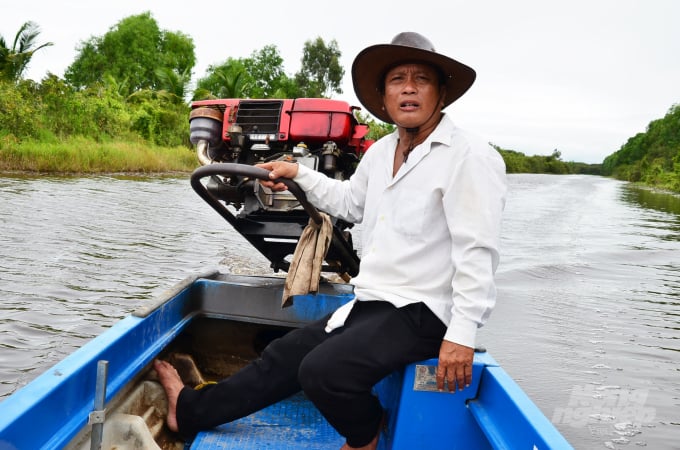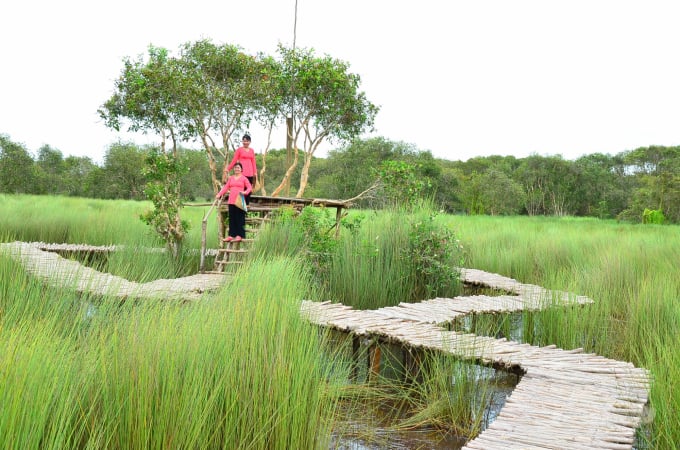June 18, 2025 | 13:39 GMT +7
June 18, 2025 | 13:39 GMT +7
Hotline: 0913.378.918
June 18, 2025 | 13:39 GMT +7
Hotline: 0913.378.918
The wheels rattled against the rocks, going steadily on the road with each side being less than an inch from the edge of the canal and the field. My heart almost jumped out of my chest. Holding the camera bag, I jumped out of the car. One part of me wished to be a "living traffic pole" in front of my colleague, but mostly I wanted to avoid anything that might happen to my documents of the trip.
After each turn, we had to ask for directions. We kept going for approximately 2 km like that, and finally the “Endless Fields” appeared with the bright light and the sound of people coming near and far.

The “Endless Fields” film studio. Photo: Duong Dinh Tuong.
This is the headquarters of Dong Thap Muoi Pharmaceutical Research and Development Joint Stock Company (Medyphica) in hamlet 3, old Binh Phong Thanh commune (Moc Hoa district, Long An province), now upgraded to a neighborhood but still very desolate.
Deputy Director of Medyphica Duong Van Toan said that in 2009 the unit lent the location to the movie crew to make a set for the movie "Endless Fields" (also known as "The Floating Lives"). After seeing that many people were interested in the beautiful scenery here, the company opened a tourist area called “Endless Field” in 2018. Especially there was Le Van Hung, ie "Black Hung" - a worker who was once acting in the movie became one of the regular tour guides in the area at present.
The crew at that time had two cascadeurs (stuntmen) who had trained abroad, very professional. But when they drove “tac rang” (a type of small motorboat) on the river, they fell everytime. In the end they had to hire "Black Hung". And the man ran the “tac rang” with ease. After turning off the engine, even when the boat did not fully stop, he jumped to the shore, as quickly as a black panther. That was how the people like him here normally do things: running the boat without brakes while it was still gliding head. Seeing that it was about to land, he ran forward to stop it with a pole, sometimes even with his own feet and hands.

"Black Hung" in the present. Photo: Duong Dinh Tuong.
Not only he was a good swimmer, a good tree climber, and the most talented tac rang driver in the reserve, but in the movie "Black Hung" also brilliantly played the role of ... a thug.
Within three months of playing a few supporting roles, he was paid VND 25 million (nearly VND 100 million based on the current gold price), enough to marry off his son. Later, the director even invited him to Saigon to film a few times, but "Black Hung" did not want to leave his wife and children, leaving the melaleuca forest.
Now he becomes a machine repair worker of Medyphica, having three meals a day and a monthly salary of VND 7 million. When the place is crowded with tourists, he becomes a tour guide. Tourism workers like him are trained by units affiliated with the company such as Saigon Tourist and Lua Viet. They receive training in communication and presentation skills.
On weekdays, they would tell tourists they are workers or pharmacists of intermediate, college and university levels serving agroproduction. On weekends, when it's crowded, the company’s entire personnel goes out to do tourism. The unit even cooperates with farmers in the buffer zone to hire them to row boats and give presentations. Some people with skillful hands can even make hats, bags from grey sedge or water chestnut to sell.

Duong Van Luc “the worker” piloting a canoe on the "Endless Fields". Photo: Duong Dinh Tuong.
Duong Van Luc's canoe splitted the water, blowing the wind away like a swallow on the canal bed amid the vast melaleuca forest. The road following the dike that surrounds the reserve was 16 km long, but most visitors preferred to go by canoe. The scent of melaleuca filled my chest and head, making my heart beat faster. After a skillful turn of the steering wheel from this worker-tour guide, the edge of the boat glided close to the purple water lilies along the banks, and the canal bed gradually narrowed.
The canoe slowed down to enter the movie set of the once famous “Endless Fields”. Amidst the vastness of grey sedges appeared a bridge made of melaleuca wood. It was built bearing the image of a map of Vietnam along with the two sacred islands of Truong Sa and Hoang Sa. Melaleuca bark was as thin as tissue paper, and there were dozens of layers that wrap the melaleuca body inside.

The tree with the tallest top represents the capital Hanoi. Photo: Duong Dinh Tuong.
And in the middle of “the sea of grey sedges”, tourists would have two forms: wet bathing and dry bathing. Wet bathing was easy to understand. You just needed to go down to the water, lie in the grass or wade in the mud. The mud was always on the move, but strangely, when you pull your feet out there was no stain on your body at all. As for dry bathing, it was to keep your clothes on and lie down with your arms and legs wide open on the melaleuca bridge.
According to Duong Van Toan, Deputy Director of the Company, there is another unique form of bathing called "forest bathing", ie immersing yourself while going through the forest. “Exercise makes sweat secreted and pores dilated, then compounds from forest trees, especially essential oils, will make their way into the body to help detoxify and increase resistance. Eyes seeing full of green, ears listening to the songs from birds above, nose breathing fresh air added with a tint of melaleuca scent, and all stress would disappear. The world encourages people to go to the forest once a month. In Vietnam, there are families who love nature and take care of their health, so they come here 3-4 times a year," said Toan.
When taking the tourists and seeing them had a need to take pictures, Luc would arrange to go to beautiful places such as Endless Fields, go to huts to fish or go to the forest for a pleasant ride. “If the tourists want to bathe, I will make arrangements to bring them to the 1km-long pool or bathing zones in the forest. If they want to hear stories, I will tell them the history of this land," Luc said.

Boats carrying tourists in the middle of the melaleuca forest. Photo: TL.
Every year, the resort welcomes 4,000 - 5,000 tourists, many of whom come to both relax and take care of their health. During the day, there are games such as making clay doll, making banana rafts, picking vegetables, and catching floating fish. At night tourists can watch water lilies bloom, fireflies fly, and then fall in love with Don Ca Tai Tu (songs of the talented).
The price for a day of experience with guides, boats and meals is only VND 500 - 600,000/person, and an overnight stay is a few hundred thousand VND more. If the tourists do not like to stay indoors, they can bring a tent to sleep in the middle of the forest, and welcome the dawn with jubilant birds. Medyphica also has a free experience for customers to grow their own trees and write their names so that they can come back over 1 year later to harvest and make essential oils. Regarding future orientation, the company plans to open nursing services to take care of elderly people.
To be continued...
Translated by Samuel Pham
![Turning wind and rain into action: [8] Real-time salinity detection and early warning technology](https://t.ex-cdn.com/nongnghiepmoitruong.vn/608w/files/news/2025/06/17/z6704423696987_15fd32ffc26d590d204d520c9dac6786-nongnghiep-151127.jpg)
(VAN) Thanks to the integration of modern hydrological-hydraulic models, remote sensing technologies, and artificial intelligence, the accuracy of hydrological forecasting has significantly improved.
![Turning wind and rain into action: [7] Early disaster warnings help marine farmers minimize losses](https://t.ex-cdn.com/nongnghiepmoitruong.vn/608w/files/news/2025/06/17/z6704423696987_15fd32ffc26d590d204d520c9dac6786-nongnghiep-142942.jpg)
(VAN) In recent years, thanks to early disaster warnings and forecasting, marine farmers in Khanh Hoa province have been able to reduce risks and losses, thereby improving production efficiency.
![Turning wind and rain into action: [6] ‘Four on-the-spot’ disaster management software](https://t.ex-cdn.com/nongnghiepmoitruong.vn/608w/files/news/2025/06/17/e5a48259d6a262fc3bb3-nongnghiep-183800.jpg)
(VAN) By simply activating the scenario on the disaster management software, the relevant authorities immediately know how many households need to be evacuated, where to evacuate them to, and by what means of transportation…
![Turning wind and rain into action: [5] Hue applies modern technology in disaster forecasting](https://t.ex-cdn.com/nongnghiepmoitruong.vn/608w/files/news/2025/06/17/z6704423696987_15fd32ffc26d590d204d520c9dac6786-nongnghiep-093938.jpg)
(VAN) In Hue city, modern technology has recently been applied in meteorological and hydrological forecasting and warning, helping to reduce the damage caused by natural disasters.

(VAN) A cutting-edge farming technique being implemented on an experimental ranch in Arizona's Sonoran Desert has already saved a billion gallons of water over five years, according to Civil Eats.

(VAN) Poultry and pig production and the environment can be boosted through enhanced water technology, according to new research.

(VAN) Coffee prices on June 16, 2025 are unchanged. In Vietnam, local trading prices are holding steady, ranging around VND 112,000 – VND 112,500/kg.